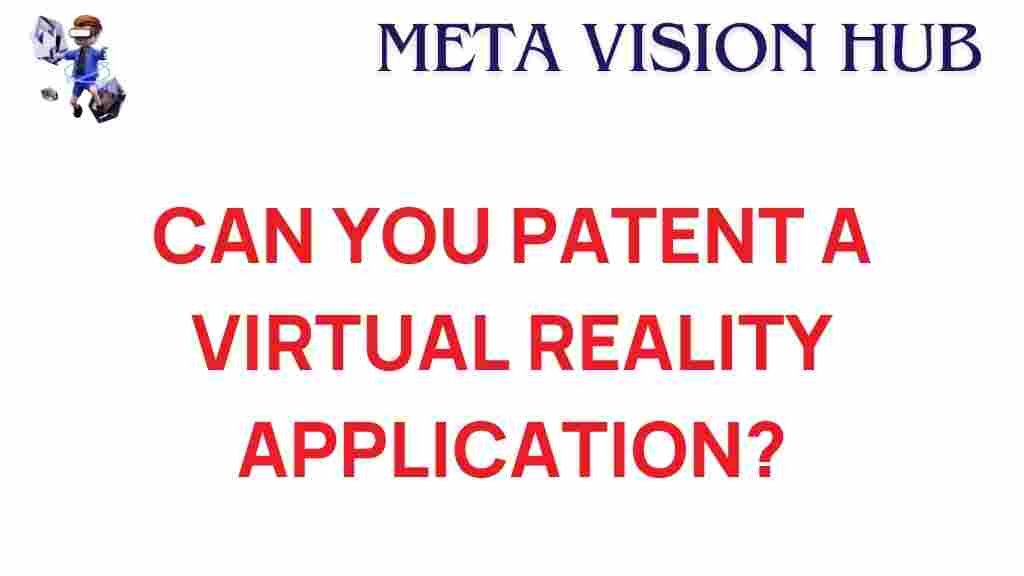In the age of groundbreaking technological innovations, *virtual reality (VR)* has emerged as a transformative force. With its applications spanning gaming, education, healthcare, and beyond, developers often grapple with one crucial question: **Can you patent a virtual reality application?** The answer lies in understanding the intricate legal maze of intellectual property rights and the patenting process. This article delves deep into the subject to guide innovators through every step.
Can You Patent a Virtual Reality Application?
The simple answer is *yes*, but with caveats. While the concept of virtual reality itself cannot be patented, specific applications, methods, and innovations within VR are eligible for patent protection. By securing a patent, you can safeguard your VR application against unauthorized use or duplication, granting you a competitive edge in the burgeoning VR industry.
What Can Be Patented in Virtual Reality?
To patent a VR application, your innovation must meet the criteria of **novelty**, **non-obviousness**, and **utility**. Here are some examples of patentable aspects in VR:
- Unique software algorithms or methods for rendering 3D environments.
- Hardware components like motion-tracking devices or haptic feedback systems.
- Innovative VR user interface designs or interaction methods.
- Specific applications targeting industries like healthcare, gaming, or real estate.
However, it’s essential to differentiate between an idea and a fully developed invention. *Patents are granted to implementations, not concepts.*
Step-by-Step Guide to Patenting a Virtual Reality Application
Patenting a VR application involves several meticulous steps. Below is a comprehensive guide:
1. Conduct a Patent Search
Before investing time and resources, perform a thorough search to ensure your idea is not already patented. Use platforms like the USPTO Patent Database or consult a patent attorney for expert assistance.
2. Document Your Invention
Detail every aspect of your VR application, including technical specifications, schematics, and a description of its functionality. A well-documented invention strengthens your patent application.
3. Determine the Patent Type
Choose between:
- Utility Patents: Cover functional aspects, processes, or systems.
- Design Patents: Protect unique visual designs or interfaces.
4. File a Provisional Patent Application
A provisional patent application (PPA) offers temporary protection and allows you to claim “patent pending” status. This step gives you a 12-month period to finalize your invention and file a non-provisional application.
5. File a Non-Provisional Patent Application
Submit a detailed patent application that includes:
- An abstract summarizing your invention.
- A full description, including diagrams or flowcharts.
- Claims defining the scope of the patent protection.
Work with a registered patent attorney to navigate this complex process effectively.
6. Wait for Examination
The patent office reviews your application to ensure compliance with legal and technical standards. This process can take several months to years, depending on the jurisdiction.
Common Challenges and Troubleshooting Tips
Patenting a VR application is not without its hurdles. Here are some common challenges and tips to overcome them:
- Ambiguity in Patent Claims: Ensure your claims are specific and clearly defined to avoid rejection.
- Rejection Based on Prior Art: Strengthen your application by highlighting the unique features and innovative aspects of your invention.
- High Costs: Patent filing and maintenance fees can be substantial. Explore government incentives or grants for small businesses and startups.
Staying proactive and working with legal experts can significantly improve your chances of obtaining a patent.
Why Patents Are Crucial for VR Innovators
Patents serve as a critical tool for VR developers by:
- **Protecting Innovations:** Prevent competitors from copying your ideas.
- **Attracting Investment:** Demonstrating intellectual property ownership enhances your credibility with investors.
- **Monetizing Inventions:** Licensing patents can create new revenue streams.
For a deeper dive into the benefits of intellectual property protection, explore our comprehensive guide.
The Future of Patents in Virtual Reality
As VR technology evolves, so does the landscape of intellectual property. Recent trends include:
- **Cross-industry Applications:** Patents covering hybrid uses of VR in areas like AI and IoT.
- **Global Protection:** Increased filings for international patents to protect innovations in multiple jurisdictions.
Staying informed about these trends ensures you remain competitive in a dynamic industry.
Conclusion
The question of whether you can patent a virtual reality application ultimately boils down to the uniqueness and functionality of your innovation. By following the steps outlined above, addressing challenges proactively, and seeking expert advice, you can successfully navigate the legal maze and secure your intellectual property.
For more insights on protecting your VR innovations, don’t hesitate to contact us or explore additional resources to strengthen your IP strategy.
This article is in the category Technology and created by MetaVisionHub Team
